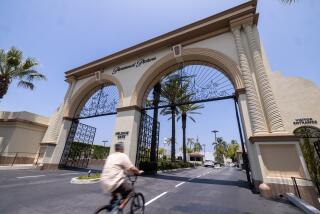Dome Theater’s Curved Screen Is Saved From Wrecking Ball
The giant, curving screen that has enthralled a generation of movie-goers at Hollywood’s Cinerama Dome theater will be saved under an agreement that ends an emotional preservation fight.
Under pressure from film buffs and facing a possible lawsuit, Pacific Theatres retreated from plans to gut the 1963 geodesic dome, announcing Tuesday that most of the Sunset Boulevard theater will remain essentially as is.
“It’s a matter of Pacific recognizing that the community really loves the theater,” said Doug Haines, a film editor and leader of the preservation effort.
Pacific will proceed with plans to renovate the concrete dome, the only movie theater of its kind.
But instead of replacing the curved Cinerama screen, digging up the theater floor to install new stadium seating and turning the lobby into a restaurant, the company will embark on a less radical revamping, upgrading the sound and projection systems and reconfiguring seating along its existing slope.
The agreement, signed by Pacific and preservation groups, clears the way for the company to proceed with a $60-million development project proposed for vacant land abutting the theater.
Responding to criticism, Pacific has also modified design of the adjacent complex, which will include restaurants, a new multiplex theater and other entertainment venues. The building height has been reduced from four to three stories, and a plaza fronting on Sunset will separate the dome and multiplex from the rest of the development.
The effort to save the dome interior has been one of the more fervent preservation crusades in recent Los Angeles memory.
“We’re saving something that is uniquely Los Angeles,” said Linda Dishman of the Los Angeles Conservancy. “I think Pacific Theatres was swayed by the passion people felt.”
Movie fans who consider the dome somewhat of a viewing temple flooded city offices with letters. They insisted it would amount to desecration to remove the screen, a remnant of the long-abandoned wide-screen Cinerama format.
Although movie industry groups and film historians rallied to the cause, Pacific remained adamant that to be competitive in today’s high-tech movie environment, the theater needed to be completely redone. The beloved curved screen distorted images and drove away exhibitors, the company argued.
But Pacific kept talking to preservationists, nudged by City Councilwoman Jackie Goldberg’s office and the Community Redevelopment Agency, which is negotiating a hefty subsidy for the project--construction of a city-owned public parking garage that sources say will cost $15 million to $20 million.
Opponents also let it be known that they would probably sue if Pacific ignored them, a threat that raised the specter of delays in the project, one of several large ventures planned in Hollywood.
In the end, Pacific relented, saying its technical staff had devised ways to correct viewing and acoustical problems without ripping out the screen.
“It was a lot of work by a lot of people to come up with solutions,” said Neil Haltrecht, Pacific’s vice president for real estate and development. “We satisfied the community and satisfied ourselves.”
The project still has to go through various city reviews and the CRA deal is not yet final, but the agreement eliminates any major opposition.
More to Read
The biggest entertainment stories
Get our big stories about Hollywood, film, television, music, arts, culture and more right in your inbox as soon as they publish.
You may occasionally receive promotional content from the Los Angeles Times.











